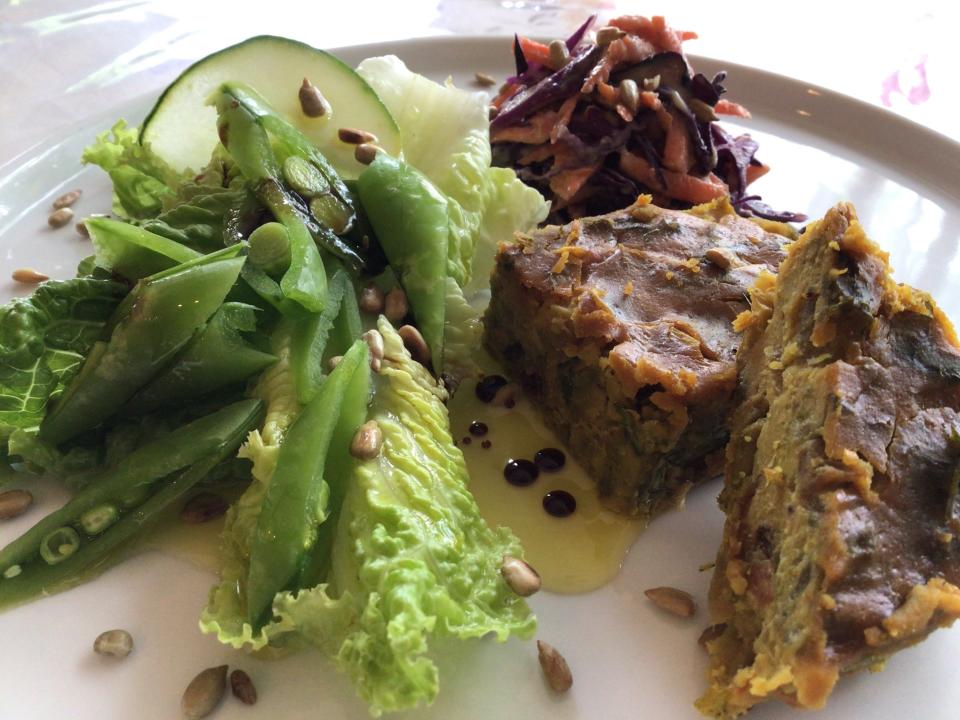Practice mindful eating with this easy-to-make frittata recipe

I am so happy to be back in Iowa City. It is such a rich and diverse city culturally and also in terms of the food that is available.
I am visiting again from the United Kingdom, for six months this time and enjoying all that is on offer here through the warmer months.
I like to shop at either Natural Grocers or New Pioneer because they have lots of organic, vegan food and the fruit and vegetables largely come "naked," rather than packaged in plastic as they do at the larger supermarkets.
Of course, the best-case scenario is buying naked, organic produce from local farmers at the Downtown Farmers Market. Supporting local growers who value biodiversity and have a passion for soil health and natural growing processes is a great investment in the future of our precious planet.
"But buying organic is expensive!" I hear some of you say.
Yes, it can cost more in monetary terms, and maybe that reflects the true cost of growing food that is more nutritious than its non-organic or genetically modified counterparts. If we are not paying the cost of sustainable food production, we can be certain that the Earth is. If we care about sustaining this planet we call home, then buying organic food is equally as important as eating a plant-based diet, and driving a smaller car — or better still, cycling!
We are what we eat, and so too is the produce. If it is raised in poor soil conditions and chemically treated, those chemicals are ultimately what we are consuming. When arable land is used for monoculture, to grow the same crops year in, year out, the soil becomes depleted of minerals and the produce is often low in nutritional content, and high in chemical content.
When we look deeply at the way our food (or anything else that we consume) is produced, our relationship with it changes. We become more mindful of the impact of our choices.
By buying organic produce, we are supporting the restoration and sustainability of the Earth. Natural is best for the Earth and therefore best for us.

My Buddhist teacher Thich Nhat Hanh says we are not separate from the Earth. We are the earth, the sun, and the rain that made the food we enjoy. The food we consume literally becomes us, our nails, cells and bones.
Understanding this, we know that if we want a healthy body we need to eat wholesome food that isn’t made from and sprayed with harmful chemicals.
There’s an organic grower in the UK who tells the story of going to visit a non-organic farm growing lettuces for a supermarket. He bent down and picked a leaf from one of the lettuces to taste it, as he did in his own fields.
Just as he got it to his mouth, the farmer shrieked: “You don’t want to do that, boy!” Because it was sprayed with chemicals.
Last week, I saw the most spectacular yellow swallowtail butterfly and yesterday I read that the Monarch butterflies are now listed as endangered. The same day, I also walked past a spectacularly manicured, chemically treated, deep green lawn that had plastic butterflies on sticks stuck in the periphery.
At first, I thought how pretty they were, then as I continued to walk I was struck by the irony of "greening" a lawn with chemicals that are contributing to the worldwide decline of insects, including butterflies, and then having to substitute the real thing with a plastic version.
Mindful eating is more than simply slowing down the digestive process, being grateful, and consuming only what we need. These are fundamental components of mindful eating, of course.
However, equally if not more important, is an awareness of the interconnection of all phenomena and the consequences of the choices we make. Choosing organic is ultimately an act of kindness and compassion for ourself, the Earth, and all species with whom we share this beautiful home.
The recipe I have chosen is a favorite from the book "I Can Cook Vegan" by Isa Chandra Moscowitz. I have cooked it many times using a variety of vegetables, including mushrooms, zucchini, asparagus, kale, corn or whatever I have at hand and is in season. It is so quick and easy to make and a favorite for vegans and non-vegans alike.
Sun-Dried Tomato and Spinach Frittata
Serves 6-8
1 large onion, diced
3 tablespoons olive oil
Salt
2 cloves garlic, minced
6 cups fresh spinach leaves
½ cup sun-dried tomatoes in oil, drained and chopped
1 teaspoon ground turmeric
2 cups vegetable broth
2 cups chickpea flour
Preheat the oven to 350 degrees. Lightly grease a 10x10-inch casserole dish
Preheat a large pan over medium heat. Sauté onion in 1 tablespoon of olive oil with a pinch of salt until translucent, about 5 minutes. Add the garlic and sauté for another minute. Add the spinach and cook until just wilted. Stir in the sun-dried tomatoes, ¾ tsp salt and turmeric, and turn off the heat.
Add the vegetable broth and remaining 2 tablespoons oil and then slowly sprinkle in the chickpea flour, stirring constantly, until the flour is absorbed and a thick batter is formed.
Transfer the mixture to the prepared casserole dish and spread out evenly. Bake for 25-28 minutes, until golden and firm on top but slightly jiggly in the middle — that means it’s not dried out. Let cool slightly, slice and serve.
Jan Goss is a life coach/therapist with a Ph.D in mindfulness. She is an ordained member of the Winding Path Sangha of Iowa City and a trained home economist.
For any questions or comments, email veganeasterniowa@gmail.com. Visit our website at VeganEasternIowa.org for more information. You can also join our group on Facebook or Meetup.
This article originally appeared on Iowa City Press-Citizen: Practice mindful eating with this easy-to-make frittata recipe

